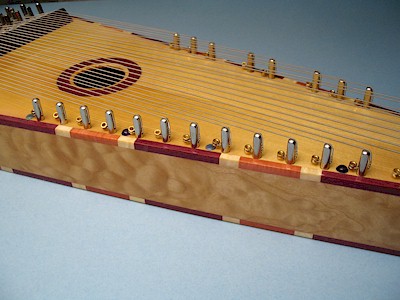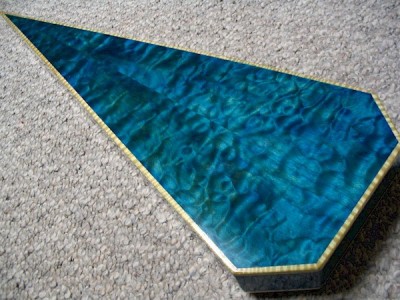by Eric Meier
Do you want that Bloodwood to stay red?
Padauk to stay orange?
Osage Orange to stay yellow?
Purpleheart to stay purple?
The lure of color
In my younger, more naive and delusionally-optimistic days of woodworking, I was immediately drawn to the intense colors of Padauk, Bloodwood, and Purpleheart—as many of us are. I imagined colorful creations that I could make that would endure for years. Despite reading multiple reports of the color in these exotic woods not lasting—and actually turning dark brown—of course I knew that the rules of the universe didn’t apply to me, and that somehow, I would beat the system.
And so I cranked out some amazingly colorful creations with exotic woods, and do you know what? They looked fantastic.

Destined for brown
And again, in my usual state of delusions, I reckoned that these colors would last forever. They had to. They looked so good. It had already been, like… three whole weeks, and no noticeable change in color had occurred, so what could any further ravages of time possibly do to my wood creations? As it turns out, plenty.
You are fighting a losing battle
I remember showing someone a section of Pink Ivory on a project that I had completed several years ago, and said, “Check it out, this is Pink Ivory. Amazing, isn’t it!?” The person, with an unbiased (and unimpressed) response said coldly, “but, it’s brown…” And then it hit me. That Pink Ivory was pink at one time, but the color had faded so gradually, to my delusional eyes it still appeared pink, when in truth, it had become an ugly brown.
Here’s my take on wood color: every piece of wood has a “freshly-cut” color, and also a “settled-in” color. Yes, most woods tend to get darker over time, but it’s not limitless: i.e., all woods do not continue to get darker and darker until they become completely black, they eventually stop at a certain hue/shade; this is what I’ll refer to as a wood’s “settled-in” color.
The problem arises in that we can only see the initial color of the wood, and have no idea where the settled-in color of the wood will end up. Imagine how differently you’d buy and use woods if you could only see the final color of the wood!
Now, we can play games, and do certain things to slow this progression (see tips below), but just realize: you are only slowing the inevitable. The wood is in the process of oxidizing and shifting in color, and it will do so sooner, or it will do so later, but it will still happen.
Dealing with reality
Here’s some insights and perspectives to take into consideration regarding wood colors:
- One nearly foolproof way to prevent color changes in woods is to hermitically seal away your project in a darkened vault. So, go ahead and store it away where no one can ever enjoy it, and you’re all set! (Please excuse my sarcasm, but I couldn’t resist.)
- You can adopt a “it was fun while it lasted mentality.” Chances are, most wood creations give the most enjoyment during the first few weeks or months of ownership, after that, people just sort of take things for granted.
- If you’re of the personality type that’s highly bugged by these sorts of things (you want to make heirlooms that endure for generations), then learn to use woods that get better with age, (such as Cherry, Mahogany, Oak, etc.) and time will be on your side!
- Use wood with interesting grain patterns to have some sort of visual interest to fall back on once the color fades (this is the Achilles’ heel of Purpleheart, which usually has very bland grain patterns.)
- If you absolutely must have a certain color *pop* on your next project, use dyes. I can’t stress this enough. Some dyed curly maple or quilted maple looks out-of-this-world, and you can tailor the color exactly how you want it, and it will actually last—provided you use quality lightfast dyes, such as TransTint.)
- Don’t be delusional. It really is only a matter of time. Like so many other things in life, you are not an exception to the rule. However, if you’re already in the midst of a project, and you want to make the best of it, see the tips below.
Tips to keep the delusion going just a little bit longer…
- Be sure to use several coats of finish to block out as much air/vapor as possible. Studies have shown that the more coats of finish that are used, the less the wood is effected by changes in humidity. Using a simple rub-in oil finish or paste wax offers very little resistance for the wood; you’re after a film-building finish.
- Keep the wood out of direct sunlight, and try to avoid placing it in areas of high light. (UV light tends to shift the color of certain woods.)
- As an extra precaution, you can use an exterior-grade spar varnish with UV inhibitors.
- If you are trying to maintain the color of a light-colored wood, such as Maple or Holly, use a water-based finish, or a finish that doesn’t yellow with age.
Colorful woods and their chromatic fate
| Wood |
Colorfast rating
(1 – 5)
| Notes |
| RED | ||
| Bloodwood | 2 | Turns a very deep reddish brown—almost black. |
| Chakte Kok | 1 | Turns brown fast, but doesn’t darken. |
| Jarrah | 2 | Inital color isn’t quite red, and settled color isn’t great either. |
| Tulipwood | 3 | Colors desaturate and shift toward brown, but maintains contrast. |
| Cocobolo | 2 | Colors can darken to nearly black, sometimes contrast is maintained. |
| ORANGE | ||
| Padauk | 2 | Turns a very deep reddish brown (lighter pieces turn brownish gray). |
| Brazilwood | 3 | Initial color isn’t always great, but retains colors slightly better. |
| Chakte Viga | 3 | Initial color isn’t always great, but retains colors slightly better. |
| Buckthorn | 3 | Starts pinkish orange, slight shift toward brown. |
| Canarywood | 3 | Colors tend to desaturate to shades of brown, still maintains contrasts. |
| YELLOW | ||
| Osage Orange | 1 | Drastic changes toward dark brown inevitable. |
| Tatajuba | 1 | Not great color to start with, not great color to end with. |
| Yellowheart | 4 | Retains color fairly well, though some browning occurs. |
| GREEN | ||
| Lignum Vitae | 2 | Darker pieces can turn nearly black. |
| Verawood | 4 | Retains olive color well, may actually increase in coloration over time. |
| Sumac | 3 | Colors desaturate to a more neutral olive-brown. |
| Pistachio | 3 | Colors desaturate to a more neutral olive-brown. |
| BLUE | ||
| Blue Mahoe | 3 | This wood is not blue, it’s a cool gray at best. Dyes give a true blue. |
| PURPLE | ||
| Purpleheart | 2 | Gives a good run for a while, but inevitably turns brown/black. |
| Bois de Rose | 1 | This wood is the worst. Expensive, endangered, and turns really black. |
| Katalox | 3 | Already nearly black, it is more suited for black than purple. |
| Kingwood | 3 | Starts a reddish purple, shifts toward brown/black. Maintains contrasts. |
| PINK | ||
| Pink Ivory | 1 | Turns brown fast, but doesn’t darken. |
| Tasmanian Myrtle | 3 | Initial color isn’t the best, but only slight shift toward brown. |
| Box Elder | 2 | Much of the color fades to brown. |
| BLACK | ||
| African Ebony | 5 | Starts black, stays black. |
| Wenge | 3 | Starts very dark, can actually lighten over time. |
| Panga Panga | 3 | Starts very dark, can actually lighten over time. |
| African Blackwood | 5 | Starts black, stays black. |
For further information log on website :
http://www.wood-database.com/wood-articles/preventing-color-changes-in-exotic-woods/







No comments:
Post a Comment